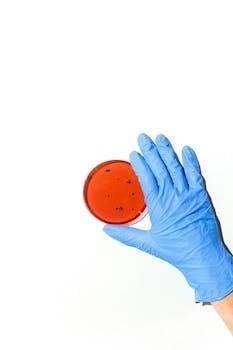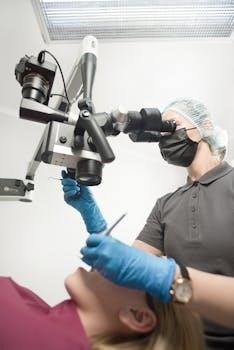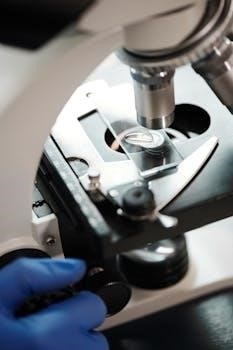microscopic examination of urine pdf

Microscopic urinalysis, a non-invasive and economical procedure, is a crucial part of physical examinations; It often reveals abnormalities not detected by other methods, providing essential diagnostic information derived from urine sediment analysis.
Importance of Microscopic Urinalysis
Microscopic examination of urine is an indispensable tool, particularly within Provider Performed Microscopy (PPM) laboratories. This method allows for the direct visualization of various cellular elements, including red blood cells, white blood cells, and epithelial cells, and also other components like crystals and casts. The information gleaned from this process helps in identifying a wide range of conditions, including urinary tract infections, kidney diseases, and metabolic disorders. Its value lies in its non-invasive nature and the ability to detect abnormalities often before they are evident through other means. Furthermore, microscopic urinalysis is a cost-effective diagnostic approach that provides essential data for patient care, making it a fundamental part of laboratory analysis. In addition, the results of microscopic urinalysis helps to correlate with other laboratory data to identify the disease.

Preparation for Microscopic Urine Examination
Proper preparation for microscopic urine examination involves careful sample collection and handling. This includes centrifuging the urine sample to concentrate the sediment for detailed analysis under a microscope.
Urine Sample Collection and Handling
The process of obtaining and handling urine samples for microscopic examination is critical to ensure accurate results. The method of collection should be carefully considered, aiming to minimize contamination and preserve the integrity of the urine components. Typically, a midstream clean-catch sample is preferred, which reduces the likelihood of contamination from external sources. This involves cleaning the urethral area before urination and collecting the urine sample midstream, avoiding the initial and final portions. Samples should be collected in sterile, leak-proof containers to prevent external contamination. Once collected, the sample should be processed promptly, ideally within one to two hours. If immediate analysis isn’t feasible, refrigeration of the sample at 2-8°C can help preserve the cellular elements and prevent bacterial growth, which might alter the analysis outcome. Proper labeling and documentation are crucial to maintain sample integrity during handling and processing, ensuring traceability and accurate interpretation of results.
Centrifugation and Sediment Preparation
After proper collection and handling, the next crucial step in preparing urine for microscopic examination is centrifugation and sediment preparation. Centrifugation is essential to concentrate the formed elements present in the urine. Typically, a specific volume of urine is placed into a centrifuge tube and spun at a controlled speed and time, often around 2000 RPM for 5-10 minutes. This process forces the heavier components, such as cells, casts, and crystals, to settle at the bottom of the tube, forming a pellet or sediment. The supernatant, which is the liquid portion above the sediment, is then carefully decanted or removed, leaving behind the concentrated sediment. The sediment is then resuspended in a small amount of the remaining urine or a suitable liquid, to create a homogenous mixture. A small drop of the resuspended sediment is placed on a glass slide, covered with a cover slip, and then it is ready for microscopic analysis. This process ensures that the cellular components are concentrated, enabling easier detection and identification during microscopic examination.

Microscopic Elements in Urine
Microscopic examination of urine sediment reveals various elements including red blood cells, white blood cells, epithelial cells, crystals, and casts. These elements provide important diagnostic clues about the patient’s health.
Red Blood Cells (RBCs)
The presence of red blood cells (RBCs) in urine, also known as hematuria, can indicate various conditions. The shape of the RBCs in fresh urine can help determine the origin of the hematuria, whether it’s glomerular or non-glomerular. In hypotonic urine, the cells may appear enlarged and colorless. Fragments and debris of red blood cells can also be observed. It’s essential to differentiate RBCs from other similar-looking elements, such as some types of crystals and artifacts like air bubbles. The quantity of RBCs is crucial for diagnosis, aiding clinicians in understanding the severity and source of bleeding. Microscopic evaluation is vital in determining the clinical significance of hematuria. Careful analysis and correlation with clinical data are necessary for accurate interpretation. The appearance of RBCs can vary based on the urine’s tonicity. The analysis requires trained personnel.
White Blood Cells (WBCs)
The presence of white blood cells (WBCs), also known as leukocytes, in urine is indicative of inflammation or infection within the urinary tract. Microscopic examination is essential for identifying and quantifying these cells. Elevated numbers of WBCs, termed pyuria, often suggest a urinary tract infection (UTI), but may also be associated with other inflammatory conditions. Proper differentiation from other elements is crucial for accurate diagnosis. The appearance of WBCs can vary, and it’s important to distinguish them from epithelial cells and other artifacts. Their presence is a key factor in determining the need for further investigations and treatment. In a laboratory setting, the trained eye can quickly identify these cells and their relative numbers. Correlation with clinical data is vital for accurate interpretation. The microscopic evaluation of WBCs is an important component of a comprehensive urinalysis. The process is a fundamental diagnostic step. The analysis is essential for patient care;
Epithelial Cells
Epithelial cells, which line the urinary tract, are commonly found in urine sediment. Their presence is generally considered normal, though increased quantities may suggest underlying issues. These cells are typically categorized into squamous, transitional, and renal tubular types, each originating from different parts of the urinary system. Squamous cells are large and flat, often derived from the distal urethra or vagina, and are most frequently observed in female samples. Transitional cells, smaller and rounder, originate from the bladder and upper urinary tract. Renal tubular cells, the smallest, are the most clinically significant as they may indicate kidney damage. Distinguishing these types is key to accurate interpretation. Careful evaluation is essential to differentiate them from other elements like WBCs or casts. Their appearance can vary, and experience is needed for proper identification. Their presence, when seen in increased numbers, can be an important diagnostic clue. Microscopic examination of epithelial cells is a vital part of routine urinalysis, aiding in the assessment of urinary tract health. Their analysis is important in clinical practice.
Crystals in Urine
Crystals in urine are a common finding during microscopic analysis, formed from the precipitation of urinary solutes. Their identification is crucial as some can be associated with specific diseases or conditions. Common types include struvite, calcium oxalate, uric acid, and cystine, each having distinctive shapes and appearances under the microscope. Struvite crystals are often coffin-lid shaped and are linked to urinary tract infections. Calcium oxalate crystals may be envelope-shaped and can indicate hyperoxaluria, often seen in patients with kidney stones. Uric acid crystals, commonly rhomboid or needle-like, are frequently associated with gout. Cystine crystals, hexagonal in shape, suggest the genetic condition cystinuria. The pH of the urine can influence crystal formation. Proper identification of crystals requires meticulous microscopic examination, sometimes with polarized light. Their presence, especially in large numbers, warrants further investigation. It is also important to distinguish them from artifacts. Thorough analysis is necessary for correct clinical interpretation, as the implications vary widely.
Casts in Urine
Urinary casts are cylindrical structures formed in the renal tubules, composed of Tamm-Horsfall protein and cellular elements. They are clinically significant as they indicate kidney disease. Hyaline casts, translucent and homogenous, are the most common and can be seen in healthy individuals. Cellular casts, such as red blood cell casts or white blood cell casts, suggest specific pathologies like glomerulonephritis or pyelonephritis, respectively. Granular casts, containing degraded cellular debris, are also seen in renal disease. Waxy casts, with a refractile, smooth appearance, indicate chronic kidney disease. Fatty casts, containing lipid droplets, are associated with nephrotic syndrome. The type and number of casts are important for diagnosis. Identification requires careful microscopic examination. Casts can be altered by urine pH and osmolality. Their presence warrants a full clinical evaluation. It’s important to differentiate them from artifacts. Careful analysis of casts is essential for accurate assessment of renal function.

Clinical Significance and Interpretation
Microscopic urinalysis findings must be correlated with clinical data and patient history. Identifying artifacts and avoiding interpretive pitfalls are vital for accurate diagnoses. The analysis assists in disease identification.
Correlation with Clinical Data and Disease
The interpretation of microscopic urine findings is not isolated; it requires careful correlation with the patient’s clinical presentation, medical history, and other laboratory results. For instance, the presence of red blood cells (RBCs) could indicate glomerular or non-glomerular bleeding, requiring further evaluation. The morphology of RBCs, whether they are intact or fragmented, can provide clues about the origin of hematuria. Similarly, white blood cells (WBCs) in the urine, along with clinical signs, might indicate a urinary tract infection (UTI) or other inflammatory conditions. The presence of specific types of crystals can be associated with metabolic disorders or kidney stone formation. Casts, which are cylindrical structures formed in renal tubules, can provide important information regarding renal disease. The identification and clinical significance of each element must be considered together for proper diagnosis and patient management. Therefore, a comprehensive approach is essential for accurate interpretation and diagnosis.
Common Artifacts and Pitfalls
Microscopic examination of urine sediment is susceptible to artifacts and misinterpretations, which can lead to diagnostic errors. Air bubbles, for example, can appear as large, spherical objects and be mistaken for cells or other structures. Fibers or other debris from the collection process or environment can also contaminate the sample and create confusion. Additionally, the use of outdated or improperly prepared urine samples can result in cell degradation, making it difficult to identify true findings. The presence of contaminants, such as starch granules from gloves, can also lead to misinterpretation. In hypotonic urine, cells may swell and become colorless, altering their appearance. It is essential to be aware of these potential pitfalls and to use proper technique, such as using fresh samples and employing appropriate preparation methods, to ensure accurate interpretation and avoid erroneous diagnoses. Careful attention to detail is crucial to distinguish between true elements and artifacts.

Resources and Atlases
Color atlases are vital for accurate urine microscopy, offering detailed images of cellular elements. Online platforms and PDF documents provide accessible resources for learning and reference, enhancing diagnostic skills.
Importance of Color Atlases
Color atlases play a crucial role in the accurate microscopic examination of urine, acting as indispensable tools for both students and seasoned professionals. These visual guides offer a comprehensive collection of high-quality photomicrographs, showcasing the diverse range of cellular and non-cellular elements found in urine sediment. The use of color is paramount, as it aids in differentiating between various structures, like red blood cells, white blood cells, epithelial cells, crystals, and casts, which can appear similar in black and white images. Furthermore, color atlases often include detailed descriptions and clinical associations for each element, enhancing the user’s understanding of the clinical significance of the microscopic findings. They also help in recognizing common artifacts, ensuring that misidentification is avoided. Such atlases are particularly beneficial in settings where Provider Performed Microscopy (PPM) is conducted, offering a reliable reference source that supports consistent and accurate diagnoses. The availability of such atlases greatly improves the overall quality and interpretation of urinalysis.
Availability of Online Resources and PDF Documents
The digital age has greatly enhanced access to resources for microscopic urine analysis, with numerous online platforms and PDF documents offering valuable information. These readily available resources include comprehensive guides, atlases, and research articles, catering to both students and professionals. Online platforms, such as J-STAGE, provide access to full-text academic journals, while websites dedicated to veterinary medicine, like eClinpath, offer specific guidance on animal urine analysis. Furthermore, downloadable PDF documents, such as those focusing on urine microscopy, are easily accessible, providing detailed descriptions and images. These digital resources facilitate learning, enabling users to study microscopic elements at their own pace. They also ensure that up-to-date information is widely available, improving the accuracy of urine sediment analysis and aiding in proper diagnosis. The convenience and accessibility of these online and PDF resources significantly enhance the educational and practical aspects of urine microscopy.